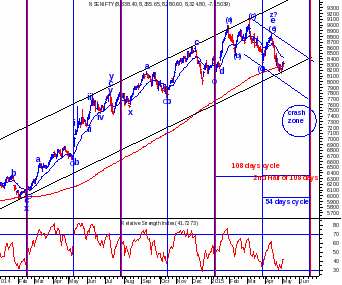Many might be still wondering and trying to figure out the logical reason for strong selloff in Indian equity markets over the past few weeks. The intensity of the down move has been increasing and Nifty is down by more than 2% without any significant news or event. This is simply showing that every pullback is now temporary and the major trend has reversed from positive to negative. During such a scenario when the movement is against the majority, the only objective technique that remains tested for time is Advanced Elliott wave – Neo Wave along with Time cycles.
It is these studies that helped us stay on the short side of the trend and constantly warn our subscribers about the impending turn in the overall trend. Now the big question is: Are we headed towards much lower levels from here or is the down move just temporary?
Let us look at a few concepts of Time cycles and Elliott wave to understand:
Nifty daily chart:

The above chart shows two important time cycles as per Hurst’s analysis – 54 days and 108 days cycle. The cycle reaches its maximum downside acceleration at the zone of 75% completion. 108 days cycle is now already at 73% completion so we are headed for the crash zone as per this cycle. Another cycle of 54 days is now heading towards 50% which is the topping area. So after next few days this cycle will also turn on downside. So as per cycle theory there is still lot of room on downside and today’s sharp down leg can just be its first leg of accelerated momentum.
As per Neo Wave – Advanced Elliott wave: we have completed a very important uptrend that started from the lows of 5118 in August 2013. This is the first time that prices have also formed lower highs and lower lows which is classical confirmation as per DOW Theory as well.
It is now always that the technical picture gets aligned all together very accurately. Such alignment happened weeks back and probably this is the time again where everything is hinting towards the same thing: a probable crash. However, do not get carried away and use prudent stop-loss levels in case the market decides to play out otherwise.
Which stock should you buy in your very next trade?
AI computing powers are changing the stock market. Investing.com's ProPicks AI includes 6 winning stock portfolios chosen by our advanced AI. In 2024 alone, ProPicks AI identified 2 stocks that surged over 150%, 4 additional stocks that leaped over 30%, and 3 more that climbed over 25%. Which stock will be the next to soar?
Unlock ProPicks AI